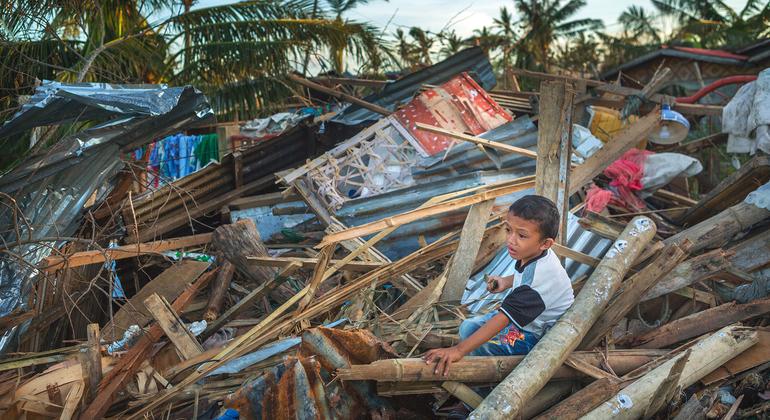Waiting for the ‘cataclysm’ – natural disasters in the Philippines: United Nations Resident Coordinator Blog

This Southeast Asian country is the most prone to natural disasters in the world, and these dangers are becoming more severe due to climate change.
the UN has worked together with Philippine authorities to prepare for a series of disasters, such as United Nations Resident Coordinator domestic, Gustavo González, explain first International Day for Disaster Risk Reduction is marked every year on October 13.
“The Philippines, with its 7,000 islands and many coastal cities, has always been vulnerable to extreme weather events and natural disasters. Every year there are about 20 storms and many can transform into super storms, which are extreme weather phenomena with great destructive power.

United Nations Resident Coordinator in the Philippines, Gustavo González, visits a community affected by Typhoon Rai, which hit the country in December 2021.
We are seeing more super typhoons as the seas in Southeast Asia warm due to climate change.
There are also about 20 active volcanoes across the country and according to experts, we can expect a magnitude 7.2 earthquake at any moment. So the serious threat of superstorms, volcanoes and earthquakes, exacerbated by climate change, forces us to prepare for a “megastorm,” a natural phenomenon has enormous destructive potential.

A family affected by the Taal volcano eruption in 2020 walks on roads covered with volcanic ash.
The Philippines ranks number one in the world World risk indexmeasure vulnerability and exposure to natural extreme events.
However, the extent of the country’s vulnerability is not well known outside the region. Indeed, when I arrived in the country as the United Nations Resident and Humanitarian Coordinator, armed with long experience in crisis situations, I immediately recognized the country’s uniqueness. This.
I realized that we needed to deeply reassess the standard toolkit for humanitarian aid and development programs used in other countries to better suit the Philippines’ unique circumstances.
In response, there has been a paradigm shift in the work of the United Nations Country Team towards investing in building resilience, that is, enhancing national and local capacity to cope and adapt. and recover from current and future shocks.
This is reflected in a very popular Filipino proverb that says “When the blanket is short, learn to bend.”
There is no one size fits all
Furthermore, our approach in the country must also take into account regional differences.
When I visited the area affected by Hurricane Odette in 2021, I assumed the area would share the same cultural identity and political dynamics as other parts of the country, but that is not the case. So.
Even on a small island, you can face completely different socioeconomic realities, in locations just a few kilometers apart. While one community may ask for a cell phone to quickly re-establish contact and show solidarity, a neighboring community may ask for livelihood support or just some materials to get started rebuild their home.
I remember an inspiring local leader on Dinagat Island who was very clear about the community’s priorities after the super typhoon. She respectfully asked questions about some of our standard and globally implemented humanitarian interventions. She considered some items redundant, while highlighting gaps in other areas and requesting customized feedback to improve feedback effectiveness.
What we learned from those experiences is that building resilience starts with recognizing the invaluable pool of knowledge, skills and assets that communities can bring. Those affected are in the best position to decide what they need and where the United Nations can add value in the aftermath of the disaster.

A boy drags furniture through flooded streets in Manila after a typhoon. (document)
Bringing such rich local knowledge into the humanitarian response represents a paradigm shift away from the standard United Nations approach. Portraying affected communities as a combination of need and vulnerability is an oversimplification of a complex reality. Developing the humility to listen, explore, and truly engage with the community is an absolute requirement.
Preparedness and resilience
Build Resilience and preparedness remain the most cost-effective way to address natural hazards such as earthquakes, floods or hurricanes. In the Philippines, ongoing decentralization gives local governments an important role in risk assessment and disaster planning as well as developing early warning systems.
I visited the United Nations Development Program and UN Habitat-supported project in Albay province, at the foot of Mayon Volcano, where communities are learning how to fly modern drones.
Digital maps of disaster-prone areas provide essential information for planning and risk assessment to better predict, prepare and mitigate the negative impacts of natural disasters and other natural hazards.
In Mindanao, I met the Bajaus people, an indigenous seafaring group whose homes were severely damaged by Super Typhoon Odette in 2021. Supported by UN Habitat, community members rebuilt their homes according to Traditional construction methods and use of locally available materials.
Recognizing and incorporating local ingenuity is critical to developing appropriate solutions. Their home is now more likely to survive the storm.
United Nations cooperation
While communities are empowered to be proactive, prepare and mitigate the impact of extreme weather or earthquakes, the United Nations is also working with governments and other partners to coordinate the international response for those potentially catastrophic events.
As the UN Resident Coordinator as well as the UN Humanitarian Coordinator, my role is first and foremost to provide global knowledge and practices for governments to use, second second is to build coalitions to support integrated humanitarian and development solutions and finally to leverage finance. resources to make them sustainable.
When I started working for the United Nations, nearly three decades ago, there was an artificial division of labor between humanitarian and development work. Such division is between programmes, strategies and budgets. Today, it is humbly acknowledged that the nature and severity of crises require a more comprehensive and integrated approach. We call it the “relationship approach.”
Our new Predictive Action Pilot* combines community knowledge, technology, digitalization and logistics into a single formula.
Generally, we only issue a 36-hour warning before a superstorm to trigger preventative action including arranging cash transfers to previously identified people. The money can help families move valuable possessions such as boats and tools as well as stockpile food or move them to evacuation centers.
Experience shows that for every dollar we invest in prevention, we save $4 on reconstruction.
As we see, facing natural disasters and vulnerability to climate change has forced Filipinos to cultivate a unique sense of resilience. The spirit of “saving lives” spread widely in the local community.
As Filipinos often say: “As long as there is life, there is hope.”
*Predictive Action Pilot Program implemented by United Nations agencies: World Food Program, UNICEFthe International Organization for Migration, the Food and Agriculture Organization and the United Nations’ sexual and reproductive health agency, UNFPAand supported by the United Nations Central Emergency Response Fund (CERF)
- The United Nations Resident Coordinator, sometimes known as the RC, is the highest-ranking representative of the United Nations United Nations development system at the national level.
- In this occasional series, UN News is inviting RCs to blog about issues important to the United Nations and the country in which they serve.
- Learn more about the United Nations’ work in the Philippines This.
- Information you need to know about the United Nations Development Coordination Office This.




